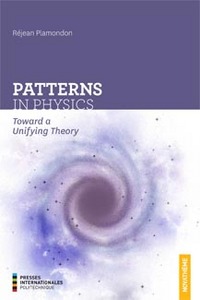Patterns in Physics: Toward a Unifying Theory
Plamondon, Rejean
Prix membre: 65,55$ (qu'est-ce que c'est?)
Prix régulier: 72,95$
Les membres économisent: 7,40$ (10%)
Prix régulier: 72,95$
Les membres économisent: 7,40$ (10%)
Disponibilité:
Disponible, expédié dans les 2 jours ouvrables
Disponible, expédié dans les 2 jours ouvrables
Éditeur:
Presses Intern. Polytechnique
Presses Intern. Polytechnique
ISBN-13:
9782553016332
ISBN-10: 2553016336
ISBN-10: 2553016336
Description:
Why are there four basic forces of Nature and where do they come
from? Why does any massive body in the Universe experience an
intrinsic rotation? What is the link between the speed of light and
the gravitational, Boltzmann and Planck constants? What are the
relationships between electron mass, the Avogadro number, vacuum
permittivity, and the masses of the Sun and the Earth? Are
dark matter and dark energy necessary to explain the observable
Universe? Can the lepton family be reduced to two members?
These are just a few of the many questions that this scientific
work addresses and to which it provides potential answers.
When various pattern analysis methods are applied to study
the Universe, this leads to considering the four interactive forces
of Nature as emerging blueprints, and the fundamental constants
as numerical primitives. Starting from two basic premises, the
principles of interdependence and of asymptotic congruence, and
using a statistical pattern recognition paradigm based on Bayes'
law and the central limit theorem, Einstein's global field equation
is generalized to incorporate a probabilistic factor that better
reflects the interconnected role of space-time curvature and
matter-energy density, providing a novel starting point to redirect
our long-term quest for the unification of physics.
from? Why does any massive body in the Universe experience an
intrinsic rotation? What is the link between the speed of light and
the gravitational, Boltzmann and Planck constants? What are the
relationships between electron mass, the Avogadro number, vacuum
permittivity, and the masses of the Sun and the Earth? Are
dark matter and dark energy necessary to explain the observable
Universe? Can the lepton family be reduced to two members?
These are just a few of the many questions that this scientific
work addresses and to which it provides potential answers.
When various pattern analysis methods are applied to study
the Universe, this leads to considering the four interactive forces
of Nature as emerging blueprints, and the fundamental constants
as numerical primitives. Starting from two basic premises, the
principles of interdependence and of asymptotic congruence, and
using a statistical pattern recognition paradigm based on Bayes'
law and the central limit theorem, Einstein's global field equation
is generalized to incorporate a probabilistic factor that better
reflects the interconnected role of space-time curvature and
matter-energy density, providing a novel starting point to redirect
our long-term quest for the unification of physics.


